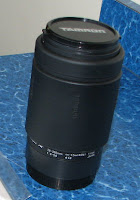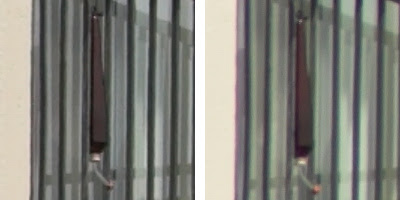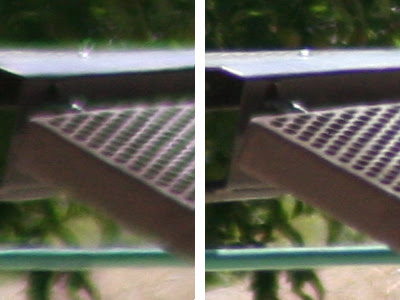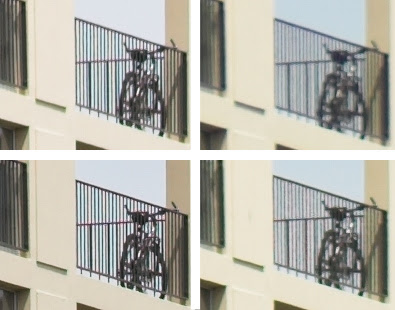 [Hello eBay-ers! Below is a review of the Tamron lens I am selling, feel free to take a look around my blog, you'll find other useful information if you are getting started in digital SLR photography!]
[Hello eBay-ers! Below is a review of the Tamron lens I am selling, feel free to take a look around my blog, you'll find other useful information if you are getting started in digital SLR photography!]
Time to scrape up some money for a 20D body by selling my Tamron AF 70-300mm F/4-5.6 LD Macro on eBay. And, as I did for the Tamron 19-35mm, I'll write a review of the lens before I sell it and include a link to it in my listing. By the way, the 70-300mm should come with front and rear caps and a hood. The skylight filter above is included in my auction, but not standard on the lens. Click to see any of these images larger!
Which Lens Is Which?
Before I start, I should clarify something: there are three different versions of the Tamron AF 70-300 LD F/4-5.6 lens. Who knows, maybe there's even more than three. There's also a 75-300 version, but it is older than the lenses listed here, so I'd generally steer clear of it. Since the easiest way to tell the lenses apart is by  appearance, make sure you get a picture of the real lens on eBay before you purchase!
appearance, make sure you get a picture of the real lens on eBay before you purchase!
1. Tamron AF 70-300mm LD F/4-5.6
$70+ shipped on eBay (used)
The non-macro LD is identified by the smooth rubber zoom ring with Tamron stamped into it. Since it lacks macro capabilities it is the least desirable of the three, but it is also the cheapest of the three. 2. Tamron AF 70-300mm LD F/4-5.6 Macro
2. Tamron AF 70-300mm LD F/4-5.6 Macro
$90+ shipped (used)
This is the lens type I am selling. You can identify it because it has two similar zoom and focus rings, but it has vertical ridges which (I assume) help you to grip it. Also, more importantly, this is marked as a macro lens. I am unsure when this was in production, but I assume it is about 10 years old.
$150 shipped (new, eBay, or on Amazon)
Finally, the Di is the newest version, currently still in production. It is easy to tell because its focus and zoom wheels have nubs, or lots of little bumps (again, probably for grip) similar to the newer lenses like the Tamron 17-50mm F/2.8. As far as I can tell, mechanically and optically it is nearly identical, it just has the Di (digital) coatings.
I won't get into the technical specs of each, but they are all pretty similar and you can see the specs on Tamron's page. All lenses cover the full 35mm frame (so you can use them on a film camera) but I can't testify about the image quality outside of the digital crop area.
Here's an eBay widget that shows live auction data. Make sure you pay attention to what version of the lens you are getting before you buy!
For the rest of this review, I'll focus on the macro non-Di version, because that is what I have experience with.
Why I Purchased the Lens
The main reason I originally purchased this lens on eBay (used) was due to the many positive reviews around the web. Here's a few:
- Photography Review
- Lensplay, 6.4/10
- Fred Miranda, 7.8/10 total rating, 9.24/10 price rating
- DPChallenge forum post
Well, the Sigma 70-300mm F/4-5.6 APO DG Macro is similar (I believe they copied Tamron, or vice-versa), but since I wanted a used lens and I heard lots of rumors about older Sigma lenses not working with the 350D (Digital Rebel XT) without re-chipping, I didn't want to take the risk. The Sigma has had some pretty good reviews and seems pretty much identical in functionality.
The Tamron has good build quality and a hood included in the price which saves you money later. It really does feel pretty solid in your hand without being overly heavy. But it does have its problems, which I'll outline in the next section.
Limitations
Of course there are limitations in a lens for this price, and the biggest ones are:
- Gets quite soft past 200mm. So much so that, once I got more finicky with my pictures, I was doing everything I could to not shoot at 300mm without being substantially stopped down (and even then it is a bit soft). A good example is the red-shouldered hawk: no matter what I did I couldn't get rid of the softness since I had to crop a decent amount.
- Chromatic aberration can be pretty bad. Really bad. Bad enough you can't totally fix it with photoshop. As long as you avoid large differences is light and dark (especially at the long end) it can be removed, but a few of my images bugged me because I could never get all the CA out. This is completely understandable though, considering a lens this cheap includes so much glass.
- The autofocus is slow and noisy. Again, not a surprise. I wish the manual focus was damped too (makes it really hard to focus). There is also some slop in the barrel and the autofocus itself, but it doesn't cause too much hunting in the zoom on my 350D.
 The lens barrel extends a long way and rotates. The
The lens barrel extends a long way and rotates. The  extension can become awkward (but looks really cool) and I was constantly worried I'd slam it into something and screw it up. The rotation is only a problem if you use a polarizing filter a lot (or happen to rest your hand on the hood). A great example of this is in these two comparison shots, side by side with my 70-200mm.
extension can become awkward (but looks really cool) and I was constantly worried I'd slam it into something and screw it up. The rotation is only a problem if you use a polarizing filter a lot (or happen to rest your hand on the hood). A great example of this is in these two comparison shots, side by side with my 70-200mm.
Performance
The best way to demonstrate the limitations of the lens is to compare it to the Canon EF 70-200mm f/4L USM with 100% crops. All of the following photos were taken in manual mode, ISO 100, RAW (same WB) similar exposure, etc. Since the sun was going in and out of clouds, the brightness isn't always consistent, but it is pretty close. Also, since these are 100% crops, clicking won't get you a bigger image. Well, except this first image, which shows the building I used as a target at 70mm, with a red line around the 200mm area.

And, before I start, I'll give the usual disclaimer that this isn't a comprehensive test of the lens. To do that, I should test corner and center sharpness on calibrated targets, but that's not really my goal. For the crops below, I attempted to choose an area with nice shapes that was near the outside of the image.
So, let's start with the 70mm comparison at F/4 and F/8. Canon is always on the left, Tamron is always on the right, and F/4 is above F/8:
Both lenses exhibit chromatic aberration since this is a pretty extreme image with high contrast vertical stripes. This is the only time I've ever seen CA on an image from the Canon lens.
Both lenses show similar results at 200mm. The Tamron is slightly worse, but not horrible, and sharpens up when stopped down. Even stopped down it isn't as sharp as the Canon wide open. That's why it's an L lens, folks. Are these good enough for daily use? Absolutely, I doubt you'd see this softness in a print unless it was an 8x10. CA is evident in both lenses, but worse in the Tamron. Definitely avoid shooting super high constrast white/black images with the lens (like zebras) or plan on fixing the CA in post processing.
Now, how about the long end? It has been theorized that the Canon at 200mm (upsized 1.5x) has better quality than the Tamron at 300mm. Let's compare:

Yup. You're better off using the Canon at 200mm than the Tamron at 300mm, even if you are stopped down. I'm not completely surprised since the Canon is such a good lens, but it is a little odd to actually see the proof.
For the final comparison, how bad is the Tamron at 300mm when wide open? Here are some late additions (handheld, ISO 400 to get 1/1000s or faster):

Wide open on the long end, the Tamron really has problems: you'll be challenged to get a decent picture at any resolution. Both the resolution and CA becomes bad enough to ruin the image. So always stop down if you need the 300mm end.
Notably, the Tamron doesn't seem to have significantly less contrast or any color issues. This is a big deal, since many inexpensive lenses have poor color reproduction and low contrast.
Overall, the Tamron performs much worse than the Canon if you really care about perfect sharpness. 100% crops are an extreme view though, and other issues often cause the image to be soft beyond lens quality (such as too slow of a shutter speed or imperfect focus). Considering it's capabilities and price point, the Tamron performs pretty well, but avoid longer than 200mm and keep it stopped down.
On the flip side, the Canon EF 70-200mm F/4 USM is a more than worthy upgrade. Wide open it is slightly sharper than the Tamron stopped down, and outperforms the Tamron even though the Tamron has a longer reach. It is almost unfair comparing the Tamron to the Canon, one of the sharpest telephoto zooms out there.
Conclusions
If you don't have $400+ to spend on a quality telephoto lens, the Tamron AF 70-300mm F/4-5.6 LD Macro makes a great starter lens. It is a great way to cheaply determine if you need a telephoto, and for that matter, if you like macro photography. It has decent resale value so you can easily get a large chunk of your money back when you upgrade.
If you pixel-peep and check each individual picture for sharpness, this may not be the lens for you, at least on the long end. As you'd expect for the price, it has its problems (soft on long end, CA, slow autofocus). But I'll tell you again, this lens is a great deal for the price, and worthy of adding to your inventory if you don't have a telephoto lens. And, it is available for both Nikon and Canon mounts! Just learn to live within its limitations, and you'll be fine. The only reason I upgraded is because I outgrew its quality.
If you have any questions, leave me a comment and I'll update the post or write a comment with the answer.





2 comments:
Great review, thanks a lot!
Your blog keeps getting better and better! Your older articles are not as good as newer ones you have a lot more creativity and originality now keep it up!
Post a Comment